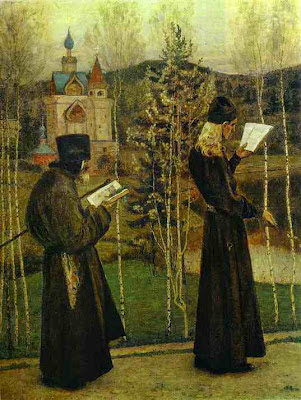'I remember stopping for a long time one day to look at a little plaque on the wall of a house in the Via degli Artisti [Rome], representing the Annunciation. An angel and a young girl, their bodies inclined towards each other, their knees bent as if they were overcome by love, 'tutto tremante', gazed upon each other like Dante's pair; and that representation of a human love so intense that it could not reach farther seemed the perfect earthly symbol of the love that passes understanding.'
From Edwin Muir's 'Autobiography'.
The Annunciation by Edwin Muir
The angel and the girl are met,
Earth was the only meeting place,
For the embodied never yet
Travelled beyond the shore of space.
The eternal spirits in freedom go.
See, they have come together, see,
While the destroying minutes flow,
Each reflects the other's face
Till heaven in hers and earth in his
Shine steady there. He's come to her
From far beyond the farthest star,
Feathered through time. Immediacy
of strangest strangeness is the bliss
That from their limbs all movement takes.
Yet the increasing rapture brings
So great a wonder that it makes
Each feather tremble on his wings.
Outside the window footsteps fall
Into the ordinary day
And with the sun along the wall
Pursue their unreturning way
That was ordained in eternity.
Sound's perpetual roundabout
Rolls its numbered octaves out
And hoarsely grinds its battered tune.
But through the endless afternoon
These neither speak nor movement make,
But stare into their deepening trance
As if their gaze would never break.
Reading Ron Ferguson's admirable if flawed book on George Mackay Brown (for it needs both tighter editing and a gentle critique when it sprawls off point), I am reminded of Edwin Muir, one of Brown's key mentors and promoters. What shimmers through Brown's accounts of Muir is the incisiveness of his judgements and the gentleness with which they were offered. Judgements always aimed at building up or expanding vision and possibility. Muir refused to review books which he could not appreciate. This is one of my favourite Muir poems that speaks of his discovery of Italy, of incarnation, of a religion embedded in a visual, tactile culture, that is of grace, acceptance and mystery.
The painting is of the Eve of the Feast of the Annunciation by Mikhail Nesterov. I love the progression of youthful monk, followed by age, both reading in the dying light of day - the rhythm of prayer meets the timing of day and the emergent season of Spring - time wrapped in eternities.
From Edwin Muir's 'Autobiography'.
The Annunciation by Edwin Muir
The angel and the girl are met,
Earth was the only meeting place,
For the embodied never yet
Travelled beyond the shore of space.
The eternal spirits in freedom go.
See, they have come together, see,
While the destroying minutes flow,
Each reflects the other's face
Till heaven in hers and earth in his
Shine steady there. He's come to her
From far beyond the farthest star,
Feathered through time. Immediacy
of strangest strangeness is the bliss
That from their limbs all movement takes.
Yet the increasing rapture brings
So great a wonder that it makes
Each feather tremble on his wings.
Outside the window footsteps fall
Into the ordinary day
And with the sun along the wall
Pursue their unreturning way
That was ordained in eternity.
Sound's perpetual roundabout
Rolls its numbered octaves out
And hoarsely grinds its battered tune.
But through the endless afternoon
These neither speak nor movement make,
But stare into their deepening trance
As if their gaze would never break.
Reading Ron Ferguson's admirable if flawed book on George Mackay Brown (for it needs both tighter editing and a gentle critique when it sprawls off point), I am reminded of Edwin Muir, one of Brown's key mentors and promoters. What shimmers through Brown's accounts of Muir is the incisiveness of his judgements and the gentleness with which they were offered. Judgements always aimed at building up or expanding vision and possibility. Muir refused to review books which he could not appreciate. This is one of my favourite Muir poems that speaks of his discovery of Italy, of incarnation, of a religion embedded in a visual, tactile culture, that is of grace, acceptance and mystery.
The painting is of the Eve of the Feast of the Annunciation by Mikhail Nesterov. I love the progression of youthful monk, followed by age, both reading in the dying light of day - the rhythm of prayer meets the timing of day and the emergent season of Spring - time wrapped in eternities.

Comments
Post a Comment